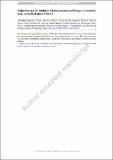Light therapy for multiple sclerosis-associated fatigue: a randomized, controlled phase II trial
Author(s)
Mateen, Farrah J; Vogel, Andre C; Kaplan, Tamara B; Hotan, Gladia C; Grundy, Sara J; Holroyd, Kathryn B; Manalo, Natalie; Stauder, Matthew; Videnovic, Aleksandar; ... Show more Show less
Download415_2020_9845_ReferencePDF.pdf (326.8Kb)
Publisher Policy
Publisher Policy
Article is made available in accordance with the publisher's policy and may be subject to US copyright law. Please refer to the publisher's site for terms of use.
Terms of use
Metadata
Show full item recordAbstract
Abstract
Background
Bright white light therapy (LT) can improve fatigue in several disease states but has not been studied in multiple sclerosis (MS).
Objective
To determine whether controlled home-based LT is feasible, tolerable, and well-adhered to in MS-associated fatigue.
Methods
A randomized, controlled trial of twice-daily 1-h bright white LT (BWLT) (10,000 lx, active arm) versus dim red LT (DRLT) (< 300 lx, control arm) was performed. Adults with MS-associated fatigue were enrolled for 10 weeks: 2-week baseline, 4-week intervention, 4-week washout.
Results
41 participants were enrolled; 35 were randomized (average age 42 years, 80% female; BWLT n = 20; DRLT n = 15). 31 were in the intention to treat analysis. The average duration of LT sessions was similar between groups (BWLT 60.9 min, DRLT 61.5 min, p = 0.70). The most commonly reported adverse event was headache. There were no events that led to discontinuation. Baseline fatigue was severe in both arms (each 53/63 points on the Fatigue Severity Scale (FSS), p = 0.92). FSS was lower following BWLT (FSS 45.8 post-LT, p = 0.04; 44.9 post-washout, p = 0.02 intra-group compared to baseline FSS) and DRLT (FSS 46.7 post-LT, p = 0.03; 43.9 post-washout, p = 0.002 intragroup compared to baseline FSS). There was no difference between BWLT and DRLT groups in the magnitude of reduction of FSS scores (p = 0.81 after LT; p = 0.77 after washout for between group comparisons). Similarly, MS quality of life metrics improved in both arms but were not significantly different between groups after LT (p = 0.22) or washout.
Conclusions
LT is safe, feasible, and well-tolerated in people with MS-associated fatigue. Improvement in both light spectra likely indicates a strong placebo effect for the DRLT group.
Date issued
2020-04-24Department
Massachusetts Institute of Technology. Department of Brain and Cognitive SciencesPublisher
Springer Berlin Heidelberg